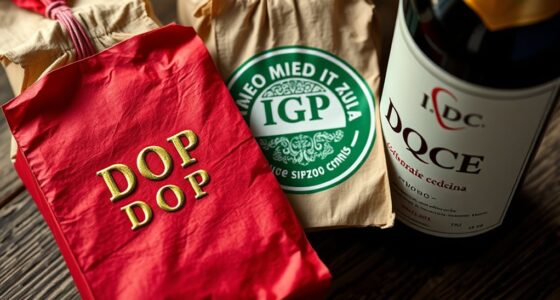To decode Italian chocolate labels, focus on the cocoa content—higher percentages mean richer flavor—while checking ingredients for simplicity and quality, like natural cocoa and vanilla. Look for regional terms such as “Modica,” which indicates a granular texture, or “Gianduia,” blending chocolate with hazelnuts. Certifications like DOP guarantee authenticity. Understanding these clues helps you pick genuine Italian chocolates that match your taste. Keep exploring, and you’ll uncover more about Italy’s rich chocolate traditions.
Key Takeaways
- Check cocoa content percentage to gauge flavor intensity; higher percentages mean richer, more intense chocolate.
- Review ingredient lists for transparency; genuine Italian chocolates use minimal, natural ingredients like cocoa, sugar, and vanilla.
- Recognize regional terms like “Modica” for Sicilian style or “Gianduia” for hazelnut blend to understand flavor profiles.
- Look for origin and certification labels (e.g., DOP, IGP) to verify regional authenticity and craftsmanship.
- Use combined label insights to select high-quality chocolates matching personal taste preferences and regional characteristics.

When you pick up a bar of Italian chocolate, understanding its label can seem tricky at first, but with a few key tips, you’ll quickly learn to decode what each ingredient and term means. One of the most straightforward clues is the cocoa content listed on the label. This percentage indicates how much of the bar is made from pure cocoa solids, including both cocoa mass and cocoa butter. Higher cocoa content usually means a richer, more intense flavor and less sweetness, which is typical of traditional Italian chocolates like those from Modica. Conversely, lower percentages tend to be sweeter and milder. Recognizing this number helps you gauge the chocolate’s intensity and quality at a glance.
Understanding cocoa content helps you choose richer, more authentic Italian chocolates.
Another important aspect is ingredient transparency. Italian chocolatiers often pride themselves on simple, high-quality ingredients, especially in regions like Piemonte or Sicily. When you examine the label, look for clear, straightforward ingredient lists. Authentic Italian chocolates typically feature minimal additives, with chocolate, sugar, and sometimes vanilla or other natural flavorings. If the label lists unfamiliar or long chemical names, it might indicate lower-quality production or mass-market chocolates. Transparent ingredient lists allow you to verify that the product is made with genuine cocoa and natural components, aligning with Italy’s tradition of craftsmanship and quality.
Decoding labels also involves understanding the terminology used. For example, “Gianduia” refers to a blend of chocolate and hazelnuts, often with a creamy texture, while “Modica” denotes a specific style of chocolate from Sicily, characterized by its granular texture and unique preparation method that preserves the cocoa’s natural flavors. Recognizing these terms helps you pick a product that matches your taste preferences. Additionally, some labels specify the origin of the cocoa beans, which can impact flavor profiles. Single-origin chocolates from regions like Venezuela, Ghana, or Madagascar often boast distinctive notes, adding another layer of appreciation for connoisseurs.
Finally, pay attention to certifications or labels indicating quality standards, such as DOP or IGP, which can assure you of traditional production methods and regional authenticity. These marks are often found on premium Italian chocolates and serve as a testament to their craftsmanship. By combining an understanding of cocoa content, ingredient transparency, and specific terminology, you can confidently navigate Italian chocolate labels, ensuring you select products that meet your taste and quality expectations. Over time, this knowledge allows you to explore Italy’s diverse chocolate landscape with ease, savoring the rich heritage behind each bar.
Frequently Asked Questions
How Can I Identify Authentic Modica Chocolate?
To identify authentic Modica chocolate, look for labels that highlight artisanal production and sustainable sourcing. Genuine Modica is made using traditional methods, resulting in a grainy texture and rich flavor. Check for certifications or specific mentions of Sicily or Modica. Avoid mass-produced options, and instead, choose small-scale producers committed to sustainable practices. These indicators assure you’re enjoying authentic, high-quality Modica chocolate crafted with care and tradition.
What Distinguishes Gianduia From Other Hazelnut Chocolates?
Imagine you’re stepping into a Willy Wonka factory—gianduia stands out with its rich, smooth flavor profile, blending roasted hazelnuts with fine chocolate. Unlike other hazelnut chocolates, it features ingredient transparency, highlighting genuine hazelnuts and high-quality cocoa. You’ll notice a velvety texture and a balanced sweetness that celebrates the nutty essence. This distinct combination makes gianduia a luxurious choice, elevating your chocolate experience beyond ordinary hazelnut confections.
Are There Specific Certifications for Italian Chocolate Labels?
You’ll find that Italian chocolate labels often feature specific certifications indicating adherence to strict production standards. These certifications, like DOP or IGP, are usually displayed prominently on the label design, assuring you of authentic, high-quality products. By checking for these labels, you can confidently identify chocolates made according to traditional methods and regional standards, ensuring you enjoy genuine Italian craftsmanship every time.
How Do Italian Chocolate Labels Indicate Cocoa Content?
Think of Italian chocolate labels as a secret code waiting to be opened. You’ll find cocoa percentage boldly displayed, like a badge of honor, often marked as “percentuale di cacao” or simply a number followed by a %. This label terminology guides you through the rich landscape of flavor intensity, revealing how much cocoa is packed inside. Keep an eye out, and you’ll decode the sweetness story behind every bar.
Can Labels Reveal Regional Origin Within Italy?
You can often tell a chocolate’s regional origin in Italy through regional branding and artisanal markings on the label. Look for specific symbols, names, or logos linked to particular areas, like Modica or Turin. These markings highlight local traditions and craftsmanship, giving you clues about where the chocolate was made. Paying attention to these details helps you appreciate the unique flavors and heritage behind each artisanal product.
Conclusion
Next time you pick up an Italian chocolate bar, remember those labels tell a story—sometimes revealing secrets you never expected. It’s funny how a simple label can connect you to Italy’s rich history and traditions, almost like a hidden message waiting to be uncovered. So, the next time you savor that gianduia or modica, know that you’re tasting centuries of passion and craftsmanship—proof that sometimes, the sweetest surprises come from the smallest details.









